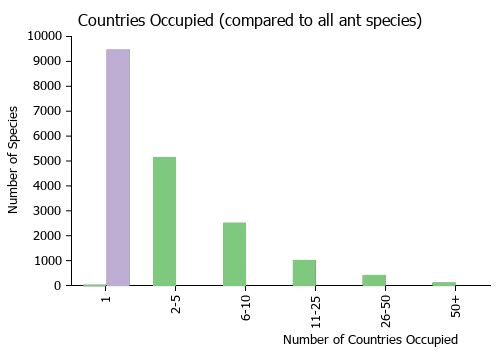Lepisiota modesta
| Lepisiota modesta | |
|---|---|

| |
| Scientific classification | |
| Kingdom: | Animalia |
| Phylum: | Arthropoda |
| Class: | Insecta |
| Order: | Hymenoptera |
| Family: | Formicidae |
| Subfamily: | Formicinae |
| Tribe: | Plagiolepidini |
| Genus: | Lepisiota |
| Species: | L. modesta |
| Binomial name | |
| Lepisiota modesta (Forel, 1894) | |
Although this species is collected infrequently it seems widespread across India. It seems to have a preference for relatively higher altitudes above 1200 m. Most of the specimens were collected under stones and from honey baits. (Wachkoo et al., 2021)
Identification
The medium-sized workers can be distinguished from the somewhat similar small to medium-sized Lepisiota annandalei by a combination of abundant erect setae on body, a transversally striate propodeal declivity and a bispinose petiolar dorsum; L. annandalei has sparse erect setae on the body, a smooth and shiny propodeal declivity and an emarginate petiolar dorsum. (Wachkoo et al., 2021)
Keys including this Species
Distribution
India (Himachal Pradesh, Jammu and Kashmir, Punjab, Uttarakhand) (Bharti et al. 2016; Wachkoo et al. 2020; Wachkoo et al., 2021).
Latitudinal Distribution Pattern
Latitudinal Range: 32.4443° to 8°.
| North Temperate |
North Subtropical |
Tropical | South Subtropical |
South Temperate |
- Source: AntMaps
Distribution based on Regional Taxon Lists
Oriental Region: India (type locality).
Distribution based on AntMaps
Distribution based on AntWeb specimens
Check data from AntWeb
Countries Occupied
| Number of countries occupied by this species based on AntWiki Regional Taxon Lists. In general, fewer countries occupied indicates a narrower range, while more countries indicates a more widespread species. |

|
Estimated Abundance
| Relative abundance based on number of AntMaps records per species (this species within the purple bar). Fewer records (to the left) indicates a less abundant/encountered species while more records (to the right) indicates more abundant/encountered species. |

|
Biology
Castes
Nomenclature
The following information is derived from Barry Bolton's Online Catalogue of the Ants of the World.
- modesta. Acantholepis modesta Forel, 1894c: 412 (diagnosis in key) (w.) INDIA. Combination in Lepisiota: Bolton, 1995b: 228.
Description
Worker
Bingham (1903): Resembles A. capensis, but is more slenderly built; mesonotum more constricted. Head narrow, oval, much longer than broad. Eyes placed laterally in the middle. Metanotum with two strong obtuse teeth. Node of the pedicel thick, bispinous, with angles laterally below the spines. Pilosity of the body longer, more abundant, very fine and very acute. Thorax and node of the pedicel of a reddish yellow, with brown markings on the back.
Length: 2.3 mm
Wachkoo et al. (2021): Head subquadrate; longer than wide, wider posteriorly than in front; lateral margins convex, posterior margin shallowly concave, with rounded posterolateral corners; clypeus carinate in the middle; anterior clypeal margin complete and convex; eyes oval, weakly convex, placed at the middle-line of head, covering about one-third of lateral cephalic margin; three small ocelli present; antennal scape surpassing posterior head margin by about one-third its length. In lateral view promesonotum convex, metanotum low, almost straight; mesometanotum demarcated; metanotal area distinct; mesometanotum constricted; propodeal spines reduced to tubercles; propodeal declivity steep. Petiole upright with angular sides, dorsally emarginate, armed with spines pointing upward.
Overall body shiny; mesometanotal suture crossribbed; mesometapleuron coarsely longitudinally striate weakly so, on lateropropodeum; propodeal declivity transversally striate. Body abundantly covered with erect setae; pubescence on body uniformly very fine and sparse; antennal funiculus with subdecumbent to suberect pubescence. Color black; scape, mandible and tarsi yellow brown.
Measurements. HL 0.60–0.67; HW 0.52– 0.63; EL 0.16–0.20; SL 0.62–0.70; PnW 0.35–0.44; ML 0.78–0.92; PFL 0.48–0.57; PFW 0.12–0.15 mm. Indices: CI 85–93; SI 110–125; REL 26–29
References
- Bharti, H. 2002. Redescription of Lepisiota modesta Forel (Hymenoptera: Formicidae: Formicinae). Annals of Forestry 10(2): 356-358. (page 356, re-description)
- Bolton, B. 1995b. A new general catalogue of the ants of the world. Cambridge, Mass.: Harvard University Press, 504 pp. (page 228, Combination in Lepisiota)
- Dias, R.K.S., Kosgamage, K.R.K.A. 2013. Occurrence and species diversity of ground-dwelling worker ants (Family: Formicidae) in selected lands in the dry zone of Sri Lanka. Journal of Science of the University of Kelaniya Sri Lanka 7: 55-72 (doi:10.4038/josuk.v7i0.6233).
- Forel, A. 1894c. Les Formicides de l'Empire des Indes et de Ceylan. Part IV. J. Bombay Nat. Hist. Soc. 8: 396-420 (page 412, (diagnosis in key) worker described)
- Harshana, A., Dey, D. 2022. Taxonomic studies on the ant genus Lepisiota Santschi 1926 (Hymenoptera: Formicidae: Formicinae) in India, with description of four new species. Oriental Insects 1–34 (doi:10.1080/00305316.2022.2125096).
- Wachkoo, A.A., Bharti, H., Akbar, S.A. 2021. Taxonomic review of the ant genus Lepisiota Santschi, 1926 (Hymenoptera: Formicidae: Formicinae) from India. Bonn Zoological Bulletin 70(2): 227–245 (doi:10.20363/BZB-2021.70.2.227).
References based on Global Ant Biodiversity Informatics
- Dias R. K. S., and K. R. K. Anuradha Kosgamage. 2012. Occurrence and species diversity of ground-dwelling worker ants (Family: Formicidae) in selected lands in the dry zone of Sri Lanka. J. Sci. Univ. Kelaniya 7: 55-72.

